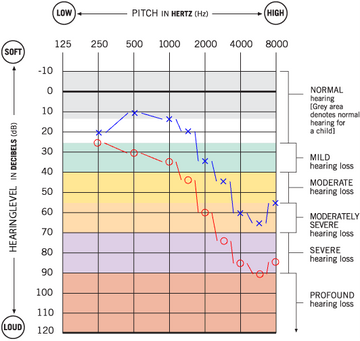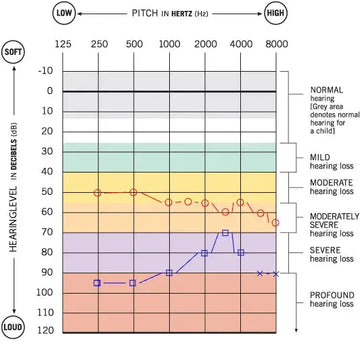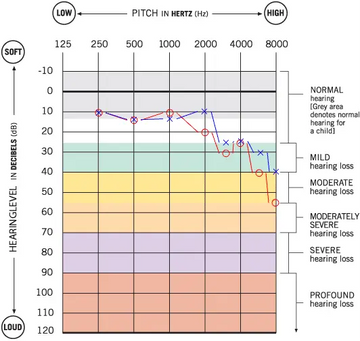By: Ashley Tilahun, Au.D., CCC-A, FAAA
Abstract
This case study presents Mr. Martin, a 78-year-old man with a history of acoustic neuroma discovered in late 2015. After an asymmetrical hearing test revealed his condition, he was fitted with Starkey Halo i110 RIC hearing aids. From 2015 to 2022, audiological assessments showed a decline and eventually stable hearing sensitivity over time. This decline was due to the growth of his right ear's acoustic neuroma and the left ear's natural aging process. In 2022, Mr. Martin switched to Starkey Evolv AI 2400 RIC hearing aids, which he said provided better sound quality and performance in difficult listening situations. Despite these improvements, he still has trouble hearing in some noisy environments. This report highlights his hearing journey, the positive impact of new hearing technology, and the importance of ongoing preventive care.
Introduction
Definition of Acoustic Neuroma
Acoustic neuroma, also known as vestibular schwannoma, is a noncancerous tumor arising from the Schwann cells covering the vestibulocochlear nerve or the eighth nerve. This nerve connects the inner ear to the brain and is vital for hearing and balance. As the tumor grows, it can compress surrounding structures, leading to various symptoms, including hearing loss, tinnitus, and balance disturbances (Stangerup et al., 2012; Chen et al., 2016). Early detection and management are crucial for preserving hearing and overall quality of life (Ben-Harosh et al., 2024).
Incidence and Prevalence of Acoustic Neuroma
Acoustic neuromas are relatively rare, with an incidence of approximately 1 per 100,000 people per year in the United States (Durham et al., 2023). They account for about 8% of all intracranial tumors and 80% of tumors in the cerebellopontine angle. These tumors are most commonly diagnosed in adults between the ages of 30 and 60, with no significant gender predisposition (Durham et al., 2023).
Mr. Martin's Case History
Mr. Martin, a 78-year-old male, was diagnosed with right-sided acoustic neuroma of the eighth cranial nerve in the Winter of 2015 after an asymmetrical hearing test revealed a significant disparity between his right and left ears. His test revealed normal to down-sloping moderately-severe sensorineural loss of the left ear and mild to profound to uprising severe sensorineural hearing loss of the right ear.

Mr. Martin’s 2015 Decibel Chart
Following his diagnosis, he was fitted with Starkey Halo i110 Receiver-in-the-Canal (RIC) hearing aids coupled to an embedded power receiver for the right ear and using a standard receiver dome for the left ear. Mr. Martin expressed that his new hearing aids at that time enhanced his ability to understand speech in various listening conditions, localize sounds, and enjoy listening to music and watching television.
Starkey Halo i110 RIC Hearing aid
Due to the possibility of his acoustic neuroma tumor growing, it was suggested by his physician to obtain a hearing test every year or sooner. Mr. Martin obtained a new hearing test in the early Spring of 2016. At that time, test results revealed normal to downsloping severe to moderately-severe sensorineural hearing loss in the left ear and mild to downsloping profound sensorineural hearing loss in the right ear, a noticeable decrease in his hearing sensitivity compared to his 2015 test results. His physician noted that Mr. Martin’s declined hearing sensitivity was due to the progressive growth of the tumor in the right ear, whereas the left ear's slight decline was due to the natural aging process.

Mr. Martin’s 2016 Decibel Chart
Continued Challenges and Progress
In 2018, Mr. Martin returned to the clinic for his much-needed updated hearing test with a complaint of struggling to understand speech, primarily in noisy situations. His updated hearing test revealed normal to downsloping moderately-severe to uprising moderate sensorineural hearing loss of the left ear and mild to downsloping profound sensorineural hearing loss of the right ear. Although there was not much of a significant change compared to his 2016 hearing test, it was noted that at 2000Hz, his left hearing threshold dropped from 25dB HL to 45dB HL. His right ear hearing sensitivity revealed no significant changes compared to the 2016 test results.
Mr. Martin’s 2018 Decibel Chart
Mr. Martin’s Starkey Halo i110 RIC hearing aids were adjusted for better listening and speech comfort. Mr. Martin continued audiological and medical care until the following year.
In the Winter of 2019, Mr. Martin returned for his updated hearing test and hearing aid cleaning and check. At that time, his test results revealed normal to downsloping moderately-severe to uprising moderate sensorineural hearing loss for the left ear and mild to downsloping profound sensorineural hearing loss for the right ear. There were no significant changes in his hearing sensitivity compared to his 2018 test results, indicating stable bilateral hearing sensitivity.
Mr. Martin returned to the clinic in the Winter of 2022 for his updated hearing test. He waited for quite some time to return to the office due to COVID-19 and other personal reasons. Mr. Martin reported a slight decrease in his hearing sensitivity as he struggled to understand speech, even in a quiet setting. He also reported struggling to understand speech while watching TV.
Mr. Martin’s updated test results revealed borderline normal to downsloping moderately-severe sensorineural hearing loss in the left ear and mild to profound sensorineural hearing loss in the right ear. It was observed that there was an overall decline in his left hearing sensitivity, whereas the right hearing sensitivity remained essentially stable when compared to the 2018 test results. Mr. Martin had Starkey Halo i110 hearing aids for about six years. Technology has remarkably improved background noise reduction and produced natural speech quality. It was recommended for Mr. Martin to consider obtaining new hearing aids for better listening needs and support. Mr. Martin was ready to try a new set of hearing aids.

Mr. Martin’s 2022 Decibel Chart
Mr. Martin transitioned to Starkey Evolv AI 2400 RIC hearing aids from Costco, significantly improving sound quality. He reported better background noise reduction, enhanced speech clarity, and overall natural sound quality with the new devices.

Starkey Evolv AI 2400 RIC Hearing Aid
Mr. Martin returned to the clinic in the Winter of 2023 for an updated hearing test and hearing aid check. He reported struggling to hear in some noisy situations; however, expressed that his current hearing devices performed better in noisy conditions compared to his previous set. He expressed that he could enjoy the TV better than he has been when comparing his new devices to his old ones. Mr. Martin’s updated test results revealed mild to normal to downsloping severe to uprising moderately-severe sensorineural hearing loss for the left ear and mild to profound sensorineural hearing loss for the right ear. His hearing sensitivity remained essentially stable when compared to the 2022 test results.

Mr. Martin’s 2023 Decibel Chart
Positive Impact with New Hearing Aid Technology
The introduction of Starkey Evolv AI 2400 RIC hearing aids marked a notable improvement in Mr. Martin's auditory experience. The advanced technology in these devices has enhanced his ability to understand speech, even in challenging listening situations. The feedback from Mr. Martin highlights the importance of continuous technological advancements in hearing aid development and their impact on patients' quality of life.
Despite these advancements, Mr. Martin struggles with hearing in noisy environments. He understands that while hearing aids significantly improve hearing, they do not restore it to normal levels.
Ongoing Preventive Care
Mr. Martin continues to receive comprehensive medical and audiological care. Regular follow-ups with his neurologist, otolaryngologist, and audiologist ensure that any changes in his condition are promptly addressed. This multidisciplinary approach is crucial in managing the acoustic neuroma and its effects on his hearing.
Conclusion
Mr. Martin's case highlights the critical role of continuous monitoring and technological advancements in managing hearing loss due to acoustic neuroma. The transition to Starkey Evolv AI 2400 RIC hearing aids significantly improved his auditory experience, demonstrating the value of newer hearing aid technologies. Regular follow-ups and a multidisciplinary approach are essential for addressing his condition's audiological and medical aspects. Despite the inherent limitations of hearing aids, the progress in sound quality and speech clarity provides a promising outlook for patients facing similar challenges.
Audiologist's Takeaway
As an audiologist, it is essential to monitor changes in hearing sensitivity through hearing exams, as Mr. Martin's primary care physician recommended, to ensure that his acoustic neuroma is not growing and causing further complications. Mr. Martin is scheduled for updated hearing tests in Winter 2024. He has reported that he continues to function well with his current hearing aids. His case underscores the importance of routine hearing assessments and advanced hearing aids to treat and manage hearing loss associated with acoustic neuroma. Although he still faces challenges, especially in noisy environments, the overall improvements in sound quality and speech understanding demonstrate the benefits of modern hearing aids.
References
1.Stangerup, S. E., & Caye-Thomasen, P. (2012). Epidemiology and natural history of vestibular schwannomas. Otolaryngologic clinics of North America, 45(2), 257–vii.
https://doi.org/10.1016/j.otc.2011.12.008
2.Chen, M., Fan, Z., Zheng, X., Cao, F., & Wang, L. (2016). Risk factors of acoustic neuroma: systematic review and meta-analysis. Yonsei medical journal, 57(3), 776-783. https://synapse.koreamed.org/upload/synapsedata/pdfdata/0069ymj/ymj-57-776.pdf
3.Durham, A. R., Tooker, E. L., Patel, N. S., & Gurgel, R. K. (2023). Epidemiology and risk factors for development of sporadic vestibular schwannoma. Otolaryngologic Clinics of North America, 56(3), 413-420.
4.Starkey Hearing Technologies. (2024). Starkey Evolv AI: Features and Benefits. Retrieved from Starkey Pro Website.
https://www.starkeypro.com/products/hearing-aids/evolv-ai
5.Ben-Harosh, L., Barker-Collo, S., Nowacka, A., Garrett, J., & Miles, A. (2024). Quality of life and broader experiences of those with acoustic neuroma: a mixed methods approach. Brain Impairment, 25(1).
https://www.publish.csiro.au/ib/Fulltext/IB23072
***Please Note: To safeguard the individual's privacy, the name has been changed in this article.
***Disclaimer: The content presented here serves general informational purposes and is not intended as professional advice or a replacement for medical consultation. It is essential to seek personalized guidance and assistance from a qualified physician or hearing healthcare provider for any specific questions, concerns, or individual health conditions related to hearing. A professional in the field can offer a comprehensive evaluation and suitable recommendations based on your unique circumstances. Ignoring or postponing seeking medical or professional help may have negative impacts on your health. Always consult with a healthcare professional for precise diagnosis, appropriate treatment, and personalized advice concerning your hearing health.***






